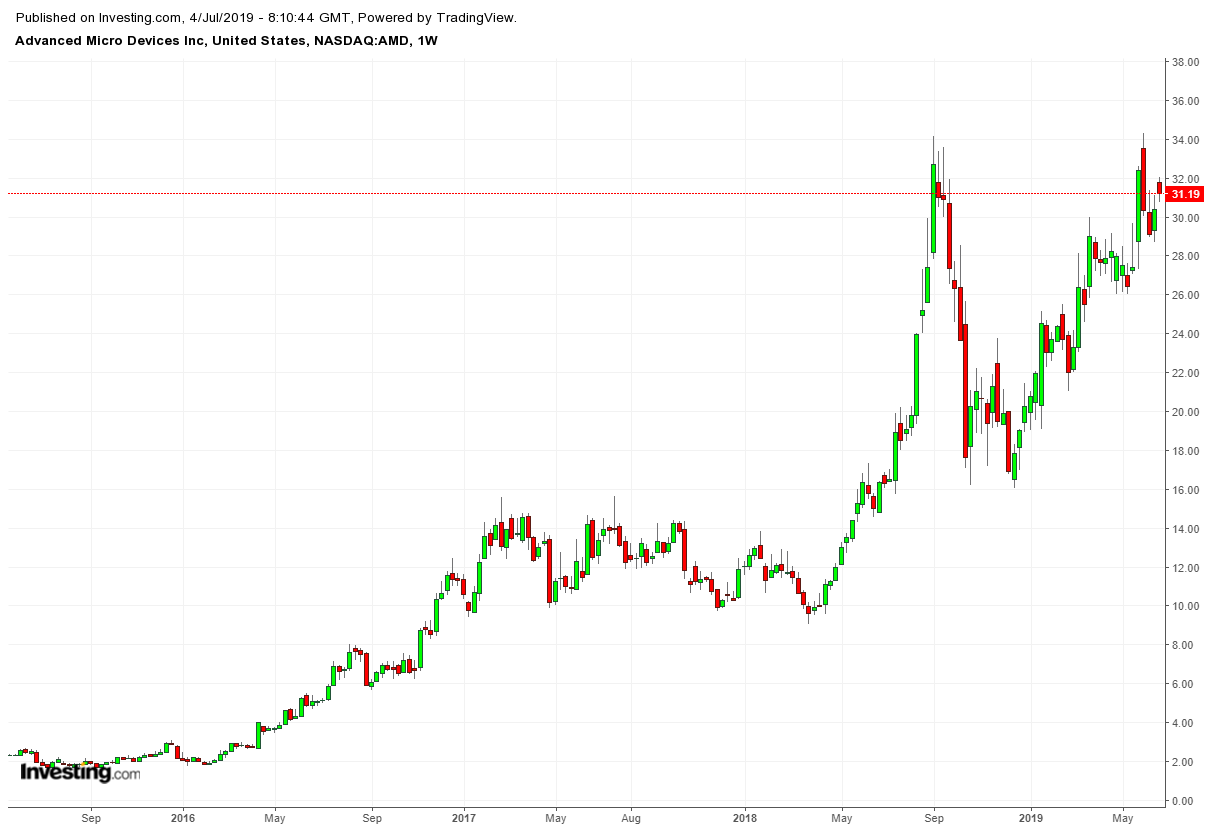Almost exactly four years to the day after Advanced Micro Devices (NASDAQ:AMD) teetered on the edge of extinction, the manufacturer of microprocessors (CPUs) and graphic processing units is back from the dead—and its stock is up an astonishing 1840% from where it was trading during July 2015.
At that time, AMD shares hit an all-time low of $1.61.
Fast-forward to July 2019: the stock closed yesterday at $31.19, just 9% off its 13-year high of $34.3. How exactly did AMD manage to turn things around, and what might that indicate about their prospects going forward?
Strategic Positioning
Founded in 1969, the California-based company didn't enter the CPU business until 1996. For most of the 21st century, AMD's offerings competed at the lower end of the chip market. Their traditional customer was a budget-conscious, computer enthusiast. AMD products were considered decent and were often sold at lower prices than competitive products.
This strategic focus made AMD a household name in the early 2000s. Unfortunately though AMD’s products were popular, its low-margin strategy wasn't profitable.
In 2015, as market leader Intel (NASDAQ:INTC) struggled to develop its newest generation of chips, AMD management saw an opportunity and decided to pivot to the high end, by developing products that would compete directly with Intel and NVIDIA (NASDAQ:NVDA) products. The shift has delivered revenue growth for AMD three years running with gains of 8%, 21%, and 23% respectively from 2016-2018.
Technological Edge
In order to make the shift to producing higher-end products, AMD had a serious product performance gap that needed to be closed, and quickly. In this, the company benefited as much from their own strategic ingenuity as they did from the market breach caused by Intel’s stagnation.
Intel chips had been stuck with 14nm processor and architecture since 2014. They'd originally promised to bring a 10nm processor in 2015, but repeatedly encountered production problems, initially pushing the release to 2017, then to Q3 2019. As of this writing, it will be almost five years since Intel chips have made a significant microarchitecture advancement.
AMD on the other hand, switched up their manufacturing processes and started working with Taiwan Semiconductor Manufacturing Company (NYSE:TSM), using TSMC's services to manufacture AMD-designed chips. The collaboration provided the U.S. chipmaker with a few advantages, chief among them the access to TSMC’s 7nm microarchitecture, which offers better per-core frequency which adds more computing power to each chip.
These improvements now put AMD's newest generation of CPUs—scheduled to be launched on July 7—on equal footing with the chip performance from Nvidia and Intel, but at a lower price price point. AMD's Ryzen 5 CPU will sell for $199 versus rival Intel's i9-9900k, which retails for $499.
Breakthrough Leadership
AMD's spectacular turnaround can arguably be attributed to one particular event: the hiring of CEO Lisa Su in 2014. A PhD-holder in electrical engineering, Su is considered the centerpiece of AMD’s comeback, and is responsible for many of the strategic and manufacturing changes.
Last month, Barron’s named her one of the 'World’s Best CEOs,' for "giving Intel Corp. a run for its money." Though NVIDIA remains strong under co-founder Jensen Huang, Intel is facing management challenges under former CFO, now permanent CEO Bob Swan.
Conclusion
But as every investor knows, past performance isn't necessarily indicative of future returns. And right now, AMD shares aren't cheap.
The company is trading at 125 times current earnings and 30.7 times forward earnings. With a market cap of $34 billion, it is also trading at 5.6 times sales, having brought in $6.1 billion in revenue over the past 12 months.
Still, it appears AMD is on the way to becoming a major player though they haven't yet managed to best their two more established rivals at the high-end. Nonetheless, with two consecutive years of more than 20% revenue growth behind it, the future looks promising.
However, given the parabolic rise of its shares, it's hard not to think that investors may be getting ahead of themselves a bit. Intel and Nvidia will not be giving up positioning without a serious fight. As well, both are still way ahead of AMD when it comes to reach, war chest, sales and net income.
Intel is still the clear market leader with $70.8 billion in revenue, followed by Nvidia's $10.7 billion; AMD trails with $6.1 billion. Similarly, Intel brought in $20.5 billion in net income while Nvidia brought in $3.3 billion. AMD remains way behind at $272 million.
AMD could continue its Cinderella growth story, of course, but in our opinion the risk-reward ratio isn’t good enough right now. Wait for a pullback to provide more reasonable numbers before initiating a position.

